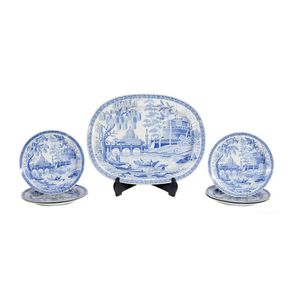Georgian Blue and White Landscape Set by Lakin
A rare Georgian blue and white transfer Ashett and six plates, with classical landscape pattern by Thomas Lakin in Stoke (1812-1817). Impressed mark, 'Lakin'. English circa 1815.
You must be a subscriber, and be logged in to view price and dealer details.
Subscribe Now to view actual auction price for this item
When you subscribe, you have the option of setting the currency in which to display prices to $Au, $US, $NZ or Stg.
This item has been sold, and the description, image and price are for reference purposes only.
- Georgian - As an English stylistic period, Georgian is usually taken to cover the period from George I (1714) to the Regency of Prince George (1811-20), although the period from 1800 to 1830 is sometimes designated as the Regency period. During the Georgian period the great English cabinetmakers and designers such as Chippendale, Hepplewhite, Adam Sheraton etc., were all active.
Therefore there isn't a single 'Georgian style' as such and to say something is 'Georgian', usually means it was made between 1714 and 1830. This assumes we discount George V and George VI, both being from the 20th century.
The styles popular at the time of each reign were:
George I (1714-1727) saw out the last years of the Baroque period.
George II (1727-1760) reigned during the Rococo period.
George III (1760-1820) saw the last gasp of the Rococo, all of the early Neo-Classic 'Adam style' and most of the later neo-Classic 'Regency style'.
George IV (Prince Regent 1820-1830)encompassed the last of the 'Regency' style.
William IV's reign (1830-1837) was something of a no man's land (stylistically) and he wasn't a 'George' anyway. He covered the last glimmerings of 'Regency' and the start of the 'Victorian' style. - Transfer Printed / Decorated Transferware - Transfer printing is method of decorating ceramics, reducing the cost of decoration when compared to employing artists to paint each piece. A print was taken on transfer-paper from an engraved copperplate, covered in ink prepared with metallic oxides, and the image on the paper was then applied to the biscuit-fired ceramic body. The print was fixed by heating the object in an oven, and then glazed, sealing the picture. Early transfer prints were blue and white, as cobalt was the only colour to stand firing without blurring. Early in the 19th century advances in the composition of the transfer paper resulted in better definition and detail, and enabled engravers to combine line-engraving with stipple.
- Circa - A Latin term meaning 'about', often used in the antique trade to give an approximate date for the piece, usually considered to be five years on either side of the circa year. Thus, circa 1900 means the piece was made about 1900, probably between 1895 and 1905. The expression is sometimes abbreviated to c.1900.
This item has been included into following indexes:
- blue & white ceramics, English & European
Visually similar items

Attributed to Arne Norell: pair of Sirocco Safari style, Sling chairs c.1960's rosewood finish frames with leather and canvas upholstery, height: 72 cm, width 66 cm depth 65 cm
Sold by
in
for
You can display prices in $Au, $US, $NZ or Stg.

Victorian gold converted bar brooch twin French jet panels
Sold by
in
for
You can display prices in $Au, $US, $NZ or Stg.

Grant Featherston B230 chair & ottoman, Australia (stamped), c 1953, 100 x 80 x 86 cm
Sold by
in
for
You can display prices in $Au, $US, $NZ or Stg.

An Australiana brooch in 9ct gold
Sold by
in
for
You can display prices in $Au, $US, $NZ or Stg.
